Nature Natter: Drought 3
• 16 november 2016
The third part of the drought post by John Gear: Spring is in the air — but WHERE is the rain?
I ended my last Blog encouraging you all to appreciate the hot dry season and to marvel at the resilience of the fauna and flora of Zandspruit. We are two months on and the challenges remain. Is it unusual to still be in the grip of a drought as we enter November? The short answer is “no”. Zandspruit receives very patchy and unpredictable rain in September and October and that is what has happened.
Some relief to the hot days
We were very fortunate to get about 25mm of rain a week ago which has given both hope and a much needed relief to the preceding hot and dessicating days. If you look carefully many grass tufts show green shoots but these will not flourish until we get more rain and those shoots that are visible are being hungrily eaten by all our herbivores and dried out by the ongoing heatwave.
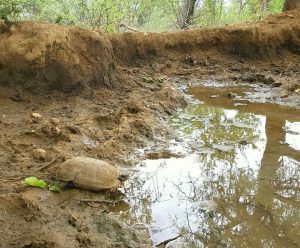
Spekes Hinged Tortoise drinking water after the rain
Despite feeding not all made it
Despite feeding we have seen a number of animals die and many that survive are stressed and poorly nourished suggesting that more may still die. It is impossible to give precise figures but our Mike Cowden’s (Estate Manager of Zandspruit Estates) best estimates suggest the following deaths in some of our major species:
- Impala
- Nyala
- Warthog
- Wildebeest
- Zebra
- Kudu
These deaths are unavoidable on a small Estate like ours and we must hope that adequate genetic diversity survives to secure a bright future for each species.
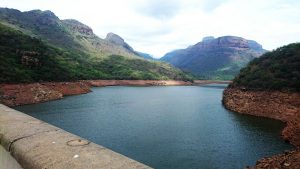
The Blyde Dam is very empty
Hope is in the air
However Spring is a time to celebrate and renew despite being a time when rain is not to be expected on Zandspruit. Take a look at a lot of the shrubs (multistemmed bushes) that are not only bursting into leaf but also flower. All along the roads are bright yellow flowers inviting bees and nectar seeking insects and birds. Most of these shrubs belong to the genus “Grewia”. These are what we lay folk call raisin bushes and they form a critical element in the food chain. Their leaves are browsed by a range of antelope, their flowers used as mentioned and their fruits are popular across a spectrum of animals. In addition to the shrubs, the large deciduous trees (trees that lose their leaves in winter) are also bursting into leaf; Zanspruit is awash with the “new green” of Spring. Hope is in the air.
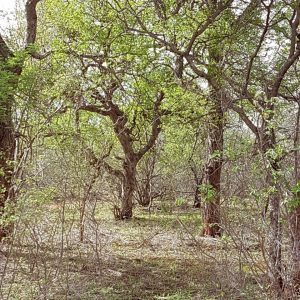
The circle of life starts small
Monkeys are now able to enjoy the young green shoots of the Buffalo Thorn (Zizyphus mucronata) despite the sharp thorns that protect these trees. There are also numerous termites, beetles and millipedes (shongololo) as they are locally known. These are going about their business of completing life cycles and in so doing provide food for many and disparate creatures ranging from the secretive nocturnal Aardvark which many of us have had the privilege of seeing on Zandspruit, to predatory birds, civets that specialise in millipedes as a delicacy, and scavenging baboons. Our dry bush is serving up a veritable smorgasbord of snacks for those who have survived the winter.
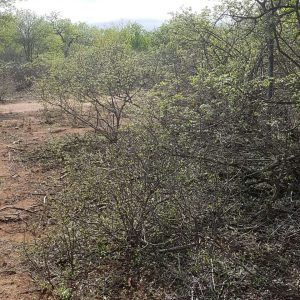
Songs of the birds
For those privileged to witness these changes there is the added bonus of a magnificent morning chorus of birds led by the White Browed Scrub Robin and the ever noisy Swainson’s and Natal Spur Fowls, the Crested Francolin and the arrow-marked Babblers. For those looking to identify more sounds in this chorus I have heard the Grey Hornbill, the Red Crested Knorhaan, the greater Blue-eared Starlings, the Orange Breasted Bush-shrike and of course the hauntingly magnificent Fish Eagle. Then there are those who are not necessarily a part of that chorus but whose busy calls punctuate the midday heat; here I think of the Grey Tit Flycatcher, the Chinspot Batis and the Woodhoopoes.
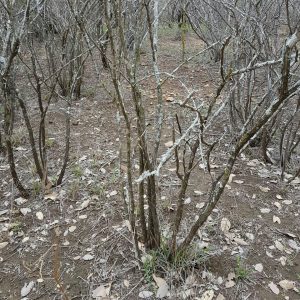
Dry bush, but the green grass is starting to grow
Sounds of the night
Night calls are equally thrilling but more limited; jackal serenading the moon, the beautiful sounds of the fiery-necked nightjar and the characteristic calls of both the Barred Owlet and little Scops Owl. These are just some of the special moments that Spring brings to Zandspruit as we wait anxiously for the drought to break. Sadly it is quite possible that this might only happen in December although prospects in November are promising. Hold thumbs and here’s hoping my next Blog will be from a stranded me on the “Island” as the Zandspruit bursts its banks!!
It is good to dream and, yes dreams can come true!!
Talking about dreams I shall chat about gardening next time: to garden or not??
Post written by John Gear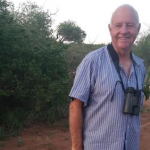
John Gear is one of the home owners of Zandspruit Bush & Aero Estate. He is a nature enthusiast and we are very excited that he contributes to our blog with his views and ideas. John welcomes corrections, challenges and contributions from each of you, so please do leave a comment below.
Tags: blyde dam, drought, hoedspruit

